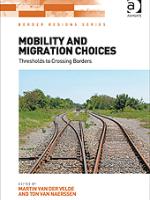Mobility and Migration Choices
The change of government in Denmark is leading to stricter migration policies. Among the measures to be adopted is a (re)imposing of border controls to combat unauthorized migration and human smuggling. The slashing of benefits for asylum seekers is another measure aimed at bringing down the number of refugees coming to the countries. In Denmark, as in most other European countries, the way to curb, re-direct or stop migration flows is one of the most-discussed issues of contemporary times and it poses many challenges for the European Union and individual member states. However, cross-border mobility is a complex process, involving decisions at many levels.
A new book tests the approach that crucial thresholds need to be crossed before mobility occurs; the individual’s mindset about migrating, the choice of destination and perception of crossing borders to that location and the specific routes and spatial trajectories available to get there. Thus both borders and trajectories can act as thresholds to spatial moves. The threshold approach, with its focus on processes affecting whether, when and where to move, aims to understand the decision-making process involved in cross-border mobility in all its dimensions, in the hope that this will lead to a better understanding of the ways migrants conceive, perceive and undertake their transnational journeys. The book examines the three constitutive parts discerned in the cross-border mobility decision-making process: people, borders and trajectories and their interrelationships. Illustrated by a global range of case studies, the book demonstrates that the relation between the three is not fixed but flexible and that decision-making contains aspects of belonging, instability, security and volatility affecting their mobility or immobility.
Senior researcher Ninna Nyberg Sørensen contributes a chapter on cross-border violence following from stricter border control measures. Focusing on a group of Guatemalans deported from the United States to Guatemala. Her chapter (11) shows that migration management has targeted undocumented migrants and instituted new forms of governing movement, people and borders. Hereby migration decisions, routes and border conceptualizations have changed, as has the conglomerate of actors linked both to the facilitation and to the control of migration. In this process the migrant receiving state has gained political currency by demonstrating effective border management. Private companies involved in detention and deportation have made huge profits, the migrant sending state has gained hard currency from remittances, while economic and social gains for the individuals, families and communities involved increasingly have been substituted by exposure to risk, violence and insecurity as well as abysmal debt. These findings, Sørensen argues, have similarities to the current European situation.
DIIS Experts


